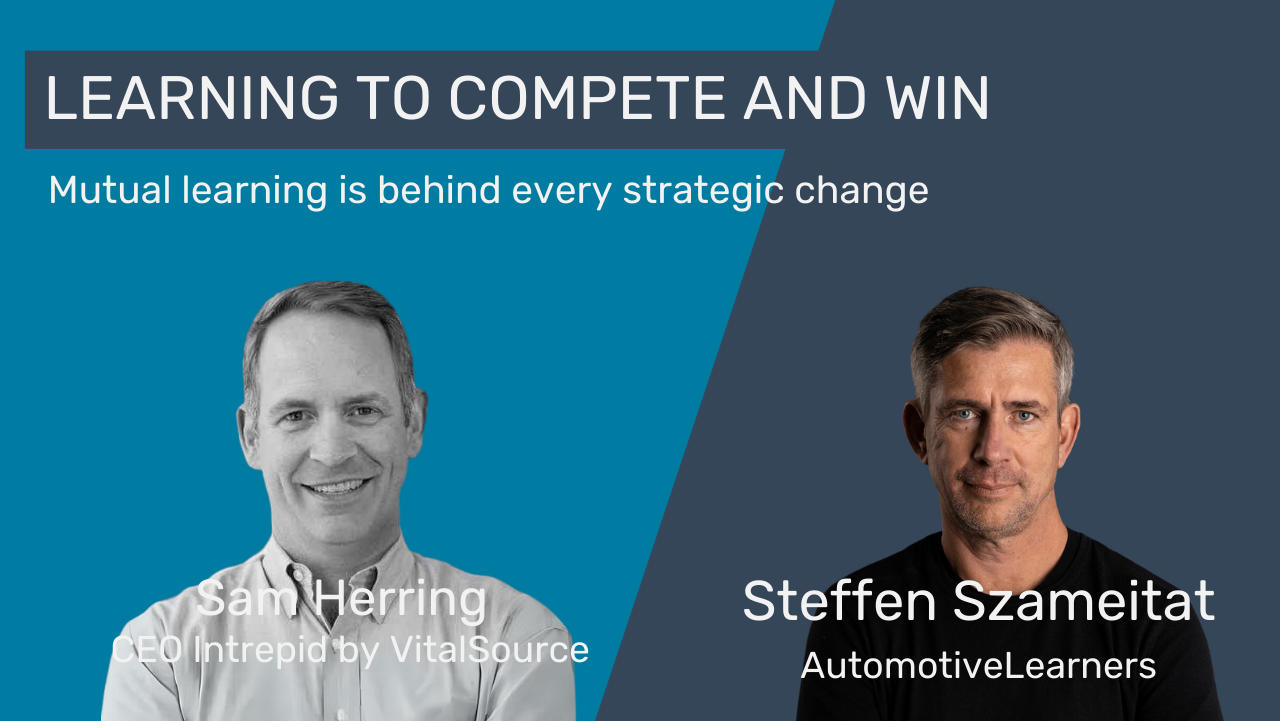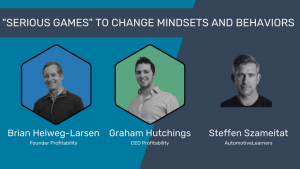Reading time: 9 Minutes
Learning together is built into our DNA as humans.
As a result, reciprocal learning produced all human knowledge, including languages and cultures. People must continue to learn from one another for society to advance. In business, success stems from trying new things, failing a few times, and learning and improving through these experiences. Because businesses are comprised of teams, social learning is critical to a company’s growth and success.
I recently spoke with Sam Herring, general manager and co-founder of Intrepid by VitalSource, a leading cohort learning platform, to understand more about social learning and the technology that enables it. Sam is a successful thought leader in corporate learning from Seattle, Washington.

Sam, since today we’ll talk a lot about the car industry, let me ask you first: What is your dream car?
Sam Herring: Oh, man. I am not really a car guy, so this may be disappointing for your audience of car aficionados. The two cars that my family and I own together show how utilitarian I am as a car owner. One is a 2015 Toyota Highlander, and the other is a 2016 Toyota Prius—highly functional family cars.
However, the next car that I buy will be electric. The car that my son and I are talking about wanting to test drive is the Ford Mustang. The Mustang is such an iconic American car as one of the popular muscle cars of the 1960s. I have always loved the 1965 Mustang, in particular. The first car that I owned was a Plymouth Barracuda, which was also very much a muscle car. I’m inspired by the new electric Mustang because it’s a bridge to the American 60s muscle car, and for me, a nostalgic connection to my younger days – and I suspect others feel the same way.
Is it that one? A Plymouth Barracuda.

Sam Herring: That’s right. It has this domed window in the back. It has a very mod 60s retro look, and that car would get up and go! It was a little dangerous for a 16-year-old to be driving, which is why I loved it! Mine was a 1965 hard top. It was a great car and a lot of fun!
Very cool, indeed. Now let’s switch gears. When you started Intrepid, what was the insight for you? Why did you start Intrepid, and why did you create the platform?
Sam Herring: With my colleagues, I helped start and run a professional services business in corporate learning, and we had grown that to a substantial size and scale. We served large global companies as customers, such as Boeing, United Airlines, and Microsoft. We sold this learning services business to Xerox, and it was folded into their corporate learning outsourcing practice.
Our experience providing learning services for large global companies gave us incredible insights into the state of online learning. It wasn’t pretty—things were very static in the corporate online learning space for a long time. We began to imagine new possibilities about 10 years ago when we saw shifts driven by the consumerization of technology, including the broad adoption of mobile and social media apps. Consumer technology began influencing enterprise technologies, which adopted a focus on user engagement.
We saw all the dreadful page-turner e-learning that had been churned out over the years and thought, “Wow, what if we could create a consumer-grade experience that provides the social learning glue for learners to connect with one another while also solving real-world work challenges at scale?” That was our insight. It wasn’t a complicated concept, but it was motivated by consumer technologies and our desire to help learners have better, more impactful digital learning experiences.
I am impressed by the simplicity of Intrepid, the technology, and the smart combination of functionalities.
Sam Herring: We also had an observation, and we still believe this is a major issue today, with the focus on upskilling their people given the rapid pace of change in skills. Many organisations do a decent job of assessing the skills that their people need to be successful in their work. But very frequently, the learning solution to developing targeted skills is simply directing individuals to a catalogue of self-directed learning and assuming that will be enough for true skill development.
But this just doesn’t deliver results. Passively reviewing content isn’t learning. Learners need to actively engage in practicing new skills, engaging with others, and reflecting on the process of learning.
These are the things that we are obsessed with. We focus on opportunities for social learning, practice through projects and assignments, and engaging learners through varied nudges, gamification, and diverse content. We are concerned with all the ingredients necessary for effective learning experiences. Content is only one piece of the puzzle.
One ideal way of learning is to sit at a library and study a book. You’re making notes while working in silence and alone. No one speaks. And this is meant to be effective learning. In comparison, what do you believe are the ideal use cases for learning in a team, group, or cohort?
Sam Herring: When I think about isolated learning, and you gave a great example of learning at a university, that is very much focused on knowledge acquisition. This is different than building a skill.
It’s interesting because isolated learning is often the default we think of when we think of the experience of learning. But isolated learning (including common forms of self-paced e-learning) is an outlier when we consider the broader human history and experience of learning.
Because if we think about how humans have learned from the dawn of time, how we learned to communicate, we needed to tell stories to each other to survive so we didn’t get eaten by the predator. We needed to pass on our heritage, our wisdom, and our culture. From this perspective, connected social learning is not a new concept. Social learning is arguably how learning started. It is deep in our DNA, and part of who we are as humans. Isolated learning and the self-paced digital forms we are surrounded by today is the outliers.
This explains why social learning has so many applications: where there is a need for deep skill building; where there is a premium on learning a nuanced craft; where the environment is dynamic and changing; where learning can be applied to solve work challenges with others; and where you need teams to work together.
Where can we apply social learning at work? There are many examples, such as onboarding new hires, where we are meeting colleagues for the first time and building important relationships. In leadership development, we can practice skills with others and share vulnerabilities with peers who are likely experiencing similar challenges. In professional development, whether those are technical or human skills, we have the opportunity to practice with others. Another example is creating diversity, equality, and inclusion learning experiences that cannot happen alone, people need to be connected with others and have the opportunity to share real experiences.
A real-life example is utilizing social learning to drive a strategic business transformation. We had a client that was changing from being a holding company to being a truly integrated operating company. And they needed to cascade a complete change across the organization to include not only the senior leaders, but all levels of management. To do that effectively, the organization needed to provide a way that managers could apply new concepts to their part of the business and have meaningful, connected and social experiences to learn from each other.
Other examples of large-scale changes in companies that benefit from social and applied learning include mergers and acquisitions and digital transformations. There are so many challenges that can be solved with social learning.
I went through Intrepid’s case studies: Telstra, Miller Heiman Group, ServiceNow, and Microsoft. What is common between them is: a team is working in one business, applying one process. And then you need to change the process, or you want to transform the business.
Sam Herring: That’s right. You found a good thread there, Steffen. Strategic change can be digital transformation or the company transforming its business from a holding company to an operating model. Microsoft’s transformation revolved around the change in their product suite from on-premise software to cloud subscriptions. ServiceNow is focused on developing partners’ competence in both ServiceNow products and consulting skills in order to drive customer adoption and success. So, it’s all about strategic transformation, upskilling individual learners to be successful, and helping organizations succeed.
What makes social learning so valuable to companies in these scenarios?
Sam Herring: Organizations are going through massive changes. Like the auto sector retooling for EVs and financial services adopting sustainable finance practices. Every organization is undergoing enormous transformations. And thinking back to just a year ago, digital transformation seemed less imminent and even a bit abstract.
But one year after the public release of ChatGPT, it doesn’t feel abstract anymore. It feels personal. If you’re a copywriter, a screenwriter, or a scriptwriter, your world is completely upended. People are thinking, “Wow, I need to stay ahead of this. I need to learn how to use these tools in order to remain relevant in my work.” And businesses are thinking, “Wow, I need to figure out how to leverage these technologies so that we can build efficiencies in my business and stay relevant as a business.”
So, it’s understandable that companies are looking for deliberately designed learning experiences to keep up with digitally-driven strategic change.
It has never been more important. It has never been more critical for your teams to come together to solve these transformational challenges that are being digitally driven.
I’ll share an example. We have a professional services client that is experiencing a digital transformation that’s fundamentally changing every part of their business, from audit and assurance to tax. For instance, audits are now using data analytics tools, so auditors need to develop skills with these tools and understand how to apply them specifically in the context of an audit. It’s no longer enough to apply what they learned in academia and through years of experience at the firm.
And we have so many examples of this from our customers, where the nature of their work is being transformed dramatically, and therefore business professionals need to learn how to adapt not only in isolation, but from one another.
It seems like the need for social learning has accelerated in comparison to what you experienced 10 to 15 years ago.
Sam Herring: Definitely. The nature of the change, the rate of change, and the capabilities that we know to drive upskilling are considerably more sophisticated than the tools of yesteryear—self-paced e-learning, virtual classrooms, WebEx, etc. We have much more pressing demand for effective upskilling, and we have richer tools now.
We briefly discussed retooling in the German automotive sector. The influence on personnel in the field is enormous. What would you say if you were asked to send a letter to the CEOs of Germany’s automobile sector?
Sam Herring: There is no need to reinforce the change that is coming their way. Not only with their products, like EVs, but also with the disruptive technologies that they can leverage throughout their businesses. For example, generative AI can revolutionize design and production, or incorporating digital and social learning into the sales process for sellers and the buying process for customers.
What I would suggest is that they consider establishing investing in digital learning academies and pathways for upskilling designers, engineers, marketers, and other knowledge workers so that they understand the possibilities and applications of cloud computing, genAI, and other emerging technologies to different aspects of their business.
An effective digital learning academy needs to include relevant, eminent expertise, whether it comes from Microsoft, Google, colleges, expert consulting companies, or wherever that expertise resides. But the expertise must be combined with providing opportunities for knowledge workers to really engage in deep skill building. Bringing an expert in for a couple of days of off-site training isn’t a sustainable, effective solution.
Relevant content is just the beginning. You have to be committed to providing an environment where continuous learning can happen, where application to the work environment via projects can happen, and where people have the opportunity to learn iteratively.
This approach could be company-specific academies, such as the Volkswagen Design Academy, or they could be cross-industrial academies.
This would be a superior alternative to the usual business consulting approach to providing cutting-edge knowledge, which is expensive, not scalable and hard to measure because it doesn’t focus on application and sustainable impact. The focus needs to be on deep, continuous skill building, which automotive companies need to own.
Thank you, Sam, for these deep insights into social learning.


